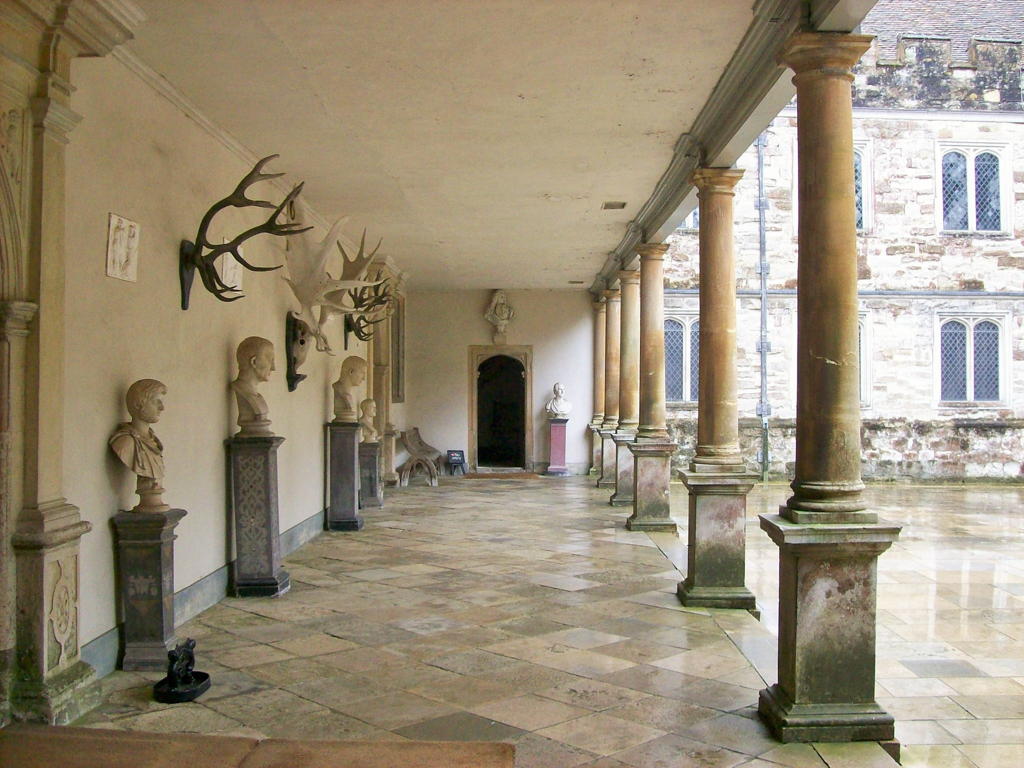A legendary ancient manor

I think I’ve seen this before… in Evil Dead.
One of the legends of early D&D adventures is the Judges Guild module Tegel Manor. It’s a sprawling “haunted house” with over 167 rooms spread out over a thirteen acre area. It looks for all the world like a slapdash construction put together by different people over several generations.
I adventured in it back in the day, but I have never run it, and I’m not sure how I could. It’s almost as impossible as my own Isle of Mordol. We had more room to spread out back then, and an ability to focus on seemingly endless tasks that my adult self envies.
I am reminded of that massive haunted house when I read about Knole House in Sevenoaks, Kent, England. The January/February 2016 issue of Archaeology Magazine has a feature article on Knole House, and describes it as “one of the five largest houses in England”. The house itself “occupies four acres, surrounded by 26 acres of gardens and fields, and another thousand that make up a medieval deer park.”
While Tegel Manor dwarfs Knole House in acreage devoted to the building, Knole House wins hands-down on number of rooms. We don’t even know how many rooms are in Knole House. “The best estimate is around 420… Each owner kept adding to it to increase their status, but they could never keep on top of using them all.”
Building began in 1445 near Bronze age burial grounds (there are mounds that may be burials in the deer park). The first owner was beheaded before he could finish building it. The son sold it to an Archbishop who finished construction—as much as you can say construction ever finished for Knole House.
There are rooms designed specifically for the King, designed during or after the Gunpowder Plot. The rooms are covered with anti-magic symbols to protect the Royal Court while staying, an astonishing thing when you think about it—during or after a massive technological bomb-based plot they remained worried about witchcraft. The magazine says that the 1605–1606 period1 was “a time of suspicion and even hysteria.”
The staff often wrote on the walls and other surfaces, but to help make clues harder to find, subsequent work on the house, if money was tight, re-used existing wood, spreading those marks to different parts of the manor.
A hundred years after the Archbishop, King Henry VIII took the house “as a royal country palace.” He may have contributed to the “unusual building techniques” found throughout the manor, as he “is known to have been a designer and architect in his own right.” The manor remained a royal holding until Queen Elizabeth I, in 1566, “granted freehold of the estate to her cousin, Thomas Sackville.”
The Sackvilles remain, and one famous resident in the early twentieth/late nineteenth century was young Vita Sackville-West, the “inspiration for Virginia Woolf’s Orlando”.
Stranger even than Tegel Manor, with rumors of an immortal aristocratic Gypsy protégé walking its halls—many of which probably haven’t even been seen for centuries, making it very possible for someone—or something—to remain hidden, this is a megadungeon en verité. In a house like that, even the ghosts might have ghosts, hidden in rooms forgotten for centuries. There might be connections to ancient burials in some room forgotten since the original construction.
And for extra violent content, its grounds may even have held England’s earliest cricket pitch.
Happy New Year, folks. The Rump family has nothing on this.
The Gunpowder Plot traditionally is dated to the fifth of November, 1605.
↑
- Archaeology
- “A publication of the Archaeological Institute of America.”
- The Evil Dead
- A true “cult classic” that involves beginning actors, a student director, and even a student producer. Director Sam Raimi later went on to do a few more Evil Deads as well as a number of other movies such as “A Simple Plan”.
- The Isle of Mordol
- An island a thousand miles from Specularum, filled with monsters and superstitious townfolk.
- Knole
- “More of a town than a house: six hundred years of history.”
- The Many Lives of an English Manor House: Kate Ravilious at Archaeology
- “Located just 30 miles outside London, the house occupies four acres, surrounded by 26 acres of gardens and fields, and another thousand that make up a medieval deer park. If the house sprawls, it is with good reason. From Sir James Fiennes to the Archbishop of Canterbury to King Henry VIII to many generations of the Sackville family, each new owner has added to its size and complexity, which has resulted in a multilevel labyrinth. It is difficult even to get an accurate count of all the rooms—the best estimate is around 420, connected to courtyards, staircases, attics, and seemingly miles upon miles of corridors.”
- Retrospective: Tegel Manor: James Maliszewski at Grognardia
- “Tegel Manor vexes me.”
- Tegel Manor Playing Aid at The Acaeum
- “A huge haunted house with over 240 rooms and chambers described including a hall of magic portraits and four secret dungeon levels beneath the manor. The booklet also has tables to create magic statues, ghostly encounters, resurrection results, and more.”
More megadungeons
- House of Gold, House of Passages
- The emperor Nero’s House of Gold sounds like the backstory of a great megadungeon right under the adventurers’ sandaled feet.
- Dwimmermount is here!
- The Maliszewski/Macris/Allison 13-level megadungeon has arrived. And it’s 400 pages of maps and craziness.
- The Isle of Mordol
- An island a thousand miles from Specularum, filled with monsters and superstitious townfolk.
